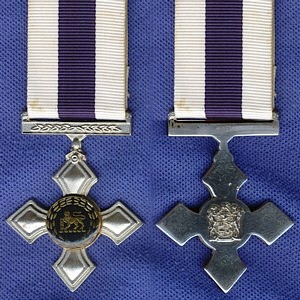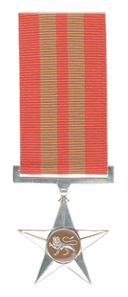
The Nkwe ya Selefera - Silver Leopard, post-nominal letters NS, was instituted by the President of the Republic of South Africa on 16 April 2003 and came into effect on 27 April 2003. It is South Africa's second highest military decoration for bravery.

The Nkwe ya Boronse - Bronze Leopard, post-nominal letters NB, is a military decoration for bravery which was instituted in 2003. It is South Africa's third highest military decoration for bravery.

The Honoris Crux of 1952, post-nominal letters HC, is a military decoration for bravery which was instituted by the Union of South Africa in 1952. It was in use from 1952 to 1975 and was awarded to members of the South African Defence Force for gallantry in action against the enemy in the field. It was discontinued on 1 July 1975, when it was replaced by a new set of four Honoris Crux decorations, in four classes.

The Star of South Africa, post-nominal letters SSA, is a military decoration for merit which was instituted by the Union of South Africa from 1952 to 1975. It was awarded to general and flag officers of the South African Defence Force for exceptionally meritorious service. The Star of South Africa was discontinued on 1 July 1975, when a new set of orders, decorations and medals was instituted.

The Van Riebeeck Decoration, post-nominal letters DVR, is a South African military decoration for bravery which was instituted by the Union of South Africa in 1952. It was awarded to officers for distinguished service in the field.

The Danie Theron Medal, post-nominal letters DTM, is a military decoration which was instituted by the Republic of South Africa in 1970 and which was in use until 1993. It was awarded for diligent service in the Commandos, the rural defence component of the South African Defence Force. Originally reserved for officers, it was available to all ranks from 1975.

The Honoris Crux Gold, post-nominal letters HCG, is a South African military decoration for bravery which was instituted in 1975. It was awarded to members of the South African Defence Force for outstanding acts of bravery while in extreme danger. It was the second most senior in a set of four classes of Honoris Crux decorations which replaced the discontinued Honoris Crux of 1952.

The Military Merit Medal, post-nominal letters MMM, is a military decoration which was instituted in the Republic of South Africa on 9 October 1974 as the Chief of the Defence Force's Commendation Medal. It could be awarded to all ranks of the South African Defence Force for service of a high order.

The Navy Cross, post-nominal letters CN is a military decoration which was instituted by the Republic of South Africa in 1987. It was awarded to members of the South African Navy for bravery. It was discontinued in 2003, but backdated awards can still be made for acts of bravery during this period.

The Pro Virtute Decoration, post-nominal letters PVD, is a military decoration for bravery which was instituted by the Republic of South Africa in 1987. It was awarded to officers of the South African Defence Force for distinguished conduct and exceptional leadership during combat operations in the field.

The Air Force Cross, post-nominal letters CA, is a South African military decoration which was instituted by the Republic of South Africa in 1987. It was awarded to members of the South African Air Force for bravery. The decoration was discontinued in 2003, but backdated awards can still be made for acts of bravery during this period.

The Medical Service Cross, post-nominal letters CC, is a military decoration which was instituted by the Republic of South Africa in 1987. It was awarded to members of the South African Medical Service for bravery. The Medical Service Cross was discontinued in 2003, but backdated awards can still be made for acts of bravery during this period.

The Ad Astra Decoration, post-nominal letters AAD, was instituted by the Republic of South Africa in 1991, to reward South African Air Force aircrew members on board aircraft for excellent airmanship or outstanding ingenuity or skill during emergencies or critically unusual situations in the air. It was discontinued in 2003, but backdated awards can still be made for acts performed during the period in effect.

The first South African military medal was a campaign medal, the South Africa Medal, instituted in 1854 by Queen Victoria, the sovereign of the United Kingdom of Great Britain and Ireland, for award to officers and men of the Royal Navy and British Army who served on the Eastern Frontier of the Cape Colony between 1834 and 1853 during the Xhosa Wars.

The Honoris Crux of 1975, post-nominal letters HC, is a military decoration for bravery which was instituted by the Republic of South Africa on 1 July 1975. The decoration was awarded to members of the South African Defence Force for bravery in dangerous circumstances. It was the junior in a set of four Honoris Crux decorations in four classes, which together replaced the discontinued Honoris Crux of 1952.

The Star of South Africa, Gold, post-nominal letters SSA, is the senior decoration of two military and five non-military classes of the Order of the Star of South Africa, a South African Order which was instituted in 1975, and awarded to general and flag officers of the South African Defence Force. The Order of the Star of South Africa was discontinued in 2002.

The Star of South Africa, Silver, post-nominal letters SSAS, was the second level decoration of two military and five non-military classes of the Order of the Star of South Africa, which was instituted by the Republic of South Africa on 1 July 1975. It was awarded to general and flag officers of the South African Defence Force for exceptionally meritorious service of major military significance. The Order of the Star of South Africa was discontinued in 2002.

The Gallantry Cross, Silver, post-nominal letters GCS, was instituted by the President of the Republic of Venda in 1985, for award to all ranks for courage or bravery or valour beyond the normal call of duty.

The Star for Bravery in Silver, post-nominal letters SBS, was instituted by the President of the Republic of South Africa in April 1996. It was awarded to veteran cadres of Umkhonto we Sizwe, the military wing of the African National Congress, who had distinguished themselves during the "struggle" by performing acts of bravery.

The Decoration for Merit in Gold, post-nominal letters DMG, was instituted by the President of the Republic of South Africa in April 1996. It was awarded to veteran cadres of uMkhonto we Sizwe, the military wing of the African National Congress, who had distinguished themselves during the "struggle" by outstanding service and utmost devotion to duty.





















